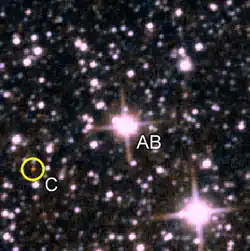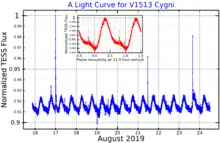Wolf 1130
Wolf 1130 is a nearby pre-cataclysmic triple star system consisting of a cold subdwarf of spectral type sdM3 (A), an ultramassive white dwarf (B) and a cold brown dwarf of spectral type sdT8 (C).[3] Wolf 1130 is 54.1 light-years (16.6 parsecs) distant from earth.
| Observation data Epoch J2000.0 Equinox J2000.0 | |
|---|---|
| Constellation | Cygnus |
| Wolf 1130 AB | |
| Right ascension | 20h 05m 02.1951s[1] |
| Declination | +54° 26′ 03.234″[1] |
| Apparent magnitude (V) | 13.883 ± 0.007 |
| Wolf 1130 C | |
| Right ascension | 20h 05m 20.38s[2] |
| Declination | +54° 24′ 33.9″[2] |
| Characteristics | |
| Spectral type | sdM3+ONe+sdT8[3] |
| Variable type | Flare star[4] |
| Astrometry | |
| Wolf 1130AB | |
| Proper motion (μ) | RA: −01159.524 mas/yr[1] Dec.: −0904.008 mas/yr[1] |
| Parallax (π) | 60.2958 ± 0.0266 mas[1] |
| Distance | 54.09 ± 0.02 ly (16.585 ± 0.007 pc) |
| Orbit[3][5] | |
| Primary | Wolf 1130A |
| Companion | Wolf 1130B |
| Period (P) | 0.497±0.003 d |
| Semi-major axis (a) | ca. 3 R☉ |
| Eccentricity (e) | 0.011±0.003 |
| Inclination (i) | 29±3° |
| Longitude of the node (Ω) | 210±19° |
| Details | |
| A | |
| Mass | 0.26[5] M☉ |
| Radius | 0.33[5] R☉ |
| Surface gravity (log g) | 4.9[3] cgs |
| Temperature | 3,530±60[3] K |
| Metallicity [Fe/H] | −0.70±0.12[3] dex |
| B | |
| Mass | 1.24+0.19 −0.15[3] M☉ |
| Radius | 0.005[3] R☉ |
| C | |
| Mass | 44.9[6] MJup |
| Radius | 0.82[6] RJup |
| Temperature | 647[6] K |
| Other designations | |
| Database references | |
| SIMBAD | Wolf 1130AB |
| Wolf 1130C | |
The system is older than 10 billion years based on UVW velocities and the low metallicity of Wolf 1130A.[3] This makes Wolf 1130C one of the oldest brown dwarfs known to science, together with LSPM J0055+5948B, which has a similar age.[7] There might be older brown dwarfs, such as WISE 1534–1043, which have less well determined ages.
The central binary
Wolf 1130A is a subdwarf of spectral type sdM3[3] with a mass of about 0.26 M☉ and a radius of 0.33 R☉. Wolf 1130A and B are tidally locked, deforming Wolf 1130A into an ellipsoid shape. The radius of Wolf 1130A is inflated up to 20% due to rapid rotation in the tidally locked system.[3][5] Wolf 1130A has a low metallicity of about [Fe/H]=−0.7 dex.[3]
Wolf 1130B is an ultramassive white dwarf with a mass of about 1.24 M☉ and it remains invisible to telescopic observations.[3] The progenitor of the white dwarf had a mass of about 6 to 8 M☉. This progenitor probably spent between 50 and 100 million years in the main-sequence before it became a giant star and engulfed Wolf 1130A in a common envelope.[3] Because of its high mass, the white dwarf Wolf 1130B is suspected to consist of oxygen, magnesium and neon (an ONe white dwarf).[3]
Wolf 1130AB is a periodic variable star with a period of 0.497 days and also a flare star, with the variable star designation V1513 Cygni. The flares occur due to material being occasionally accreted onto the surface of the white dwarf.[5] Three components cause the variability of Wolf 1130A:[3]
- ellipsoidal variability
- Doppler beaming
- thermal photometric variability
In the future the system will lose orbital energy due to effects such as magnetic braking and by emitting gravitational waves. Wolf 1130A will get close to the Roche radius of Wolf 1130B in about 6.2 billion years. At this point the system will transfer mass from the M-type subdwarf to the surface of the white dwarf, becoming a cataclysmic variable. Once the mass transfer starts, magnetic braking will gain strength, and after less than 500 million years the Wolf 1130AB pair will merge. This merger could produce a type Ia supernova. The resulting merger would be near or above the Chandrasekhar limit.[3]
The outer companion
The outer companion Wolf 1130C (WISE J200520.38+542433.9) was discovered in 2013.[9] It has a temperature of 647 K (374°C, 705°F), a radius of 0.82 RJ and a mass of 44.9 MJ.[6] The brown dwarf has a low metallicity which causes an unusually low luminosity compared to other stars of the same mass, and it is therefore classified as a subdwarf. It is suspected that it orbited Wolf 1130AB in a closer orbit when Wolf 1130B was still a main-sequence star. When Wolf 1130AB became a common-envelope binary and Wolf 1130B later a white dwarf, the entire system lost 80% of its mass and forced Wolf 1130C into a more distant orbit of 3150 astronomical units.[3]
References
- Gaia Collaboration (2022-05-01). "VizieR Online Data Catalog: Gaia DR3 Part 1. Main source (Gaia Collaboration, 2022)". VizieR Online Data Catalog: I/355. Bibcode:2022yCat.1355....0G.
- Mace, Gregory N.; Kirkpatrick, J. Davy; Cushing, Michael C.; Gelino, Christopher R.; McLean, Ian S.; Logsdon, Sarah E.; Wright, Edward L.; Skrutskie, Michael F.; Beichman, Charles A.; Eisenhardt, Peter R.; Kulas, Kristin R. (2013). "The Exemplar T8 Subdwarf Companion of Wolf 1130". The Astrophysical Journal. 777 (1): 36. arXiv:1309.1500. Bibcode:2013ApJ...777...36M. doi:10.1088/0004-637X/777/1/36. S2CID 9475960.
- Mace, Gregory N.; Mann, Andrew W.; Skiff, Brian A.; Sneden, Christopher; Kirkpatrick, J. Davy; Schneider, Adam C.; Kidder, Benjamin; Gosnell, Natalie M.; Kim, Hwihyun; Mulligan, Brian W.; Prato, L.; Jaffe, Daniel (2018-02-01). "Wolf 1130: A Nearby Triple System Containing a Cool, Ultramassive White Dwarf". The Astrophysical Journal. 854: 145. Bibcode:2018ApJ...854..145M. doi:10.3847/1538-4357/aaa8dd. ISSN 0004-637X.
- Samus, N. N.; Durlevich, O. V.; et al. (2009). "VizieR Online Data Catalog: General Catalogue of Variable Stars (Samus+ 2007–2013)". VizieR On-line Data Catalog: B/GCVS. Originally Published in: 2009yCat....102025S. 1: B/gcvs. Bibcode:2009yCat....102025S.
- Honaker, Easton J.; Mace, Gregory N.; Han, Eunkyu; Hussaini, Maryam; Lubar, Emily (2020-11-01). "TESS Photometry of the Precataclysmic Variable Wolf 1130AB". Research Notes of the American Astronomical Society. 4: 197. Bibcode:2020RNAAS...4..197H. doi:10.3847/2515-5172/abc6a4. ISSN 2515-5172.
- Zhang, Zhoujian; Liu, Michael C.; Best, William M. J.; Dupuy, Trent J.; Siverd, Robert J. (2021-04-01). "The Hawaii Infrared Parallax Program. V. New T-dwarf Members and Candidate Members of Nearby Young Moving Groups". The Astrophysical Journal. 911: 7. Bibcode:2021ApJ...911....7Z. doi:10.3847/1538-4357/abe3fa. hdl:20.500.11820/e04ec38e-f54d-46a9-8839-cc38fbf8b9f4. ISSN 0004-637X.
- Meisner, Aaron M.; Faherty, Jacqueline K.; Kirkpatrick, J. Davy; Schneider, Adam C.; Caselden, Dan; Gagné, Jonathan; Kuchner, Marc J.; Burgasser, Adam J.; Casewell, Sarah L.; Debes, John H.; Artigau, Étienne; Bardalez Gagliuffi, Daniella C.; Logsdon, Sarah E.; Kiman, Rocio; Allers, Katelyn (2020-08-01). "Spitzer Follow-up of Extremely Cold Brown Dwarfs Discovered by the Backyard Worlds: Planet 9 Citizen Science Project". The Astrophysical Journal. 899: 123. arXiv:2008.06396. Bibcode:2020ApJ...899..123M. doi:10.3847/1538-4357/aba633. ISSN 0004-637X.
- "MAST: Barbara A. Mikulski Archive for Space Telescopes". Space Telescope Science Institute. Retrieved 8 December 2021.
- Mace, Gregory N.; Kirkpatrick, J. Davy; Cushing, Michael C.; Gelino, Christopher R.; McLean, Ian S.; Logsdon, Sarah E.; Wright, Edward L.; Skrutskie, Michael F.; Beichman, Charles A.; Eisenhardt, Peter R.; Kulas, Kristin R. (2013-11-01). "The Exemplar T8 Subdwarf Companion of Wolf 1130". The Astrophysical Journal. 777: 36. Bibcode:2013ApJ...777...36M. doi:10.1088/0004-637X/777/1/36. ISSN 0004-637X.

